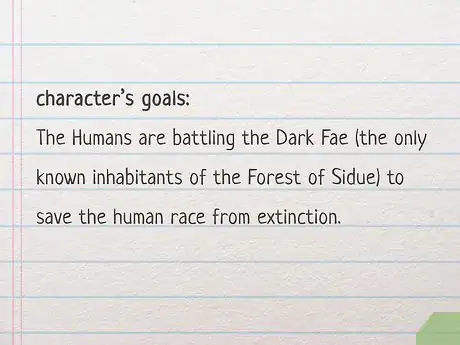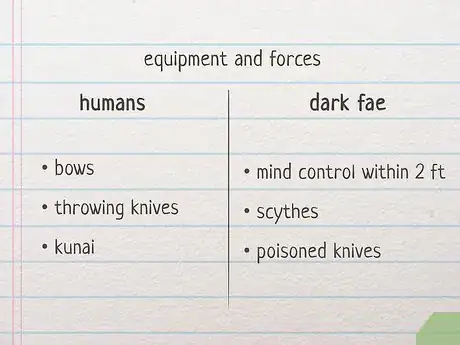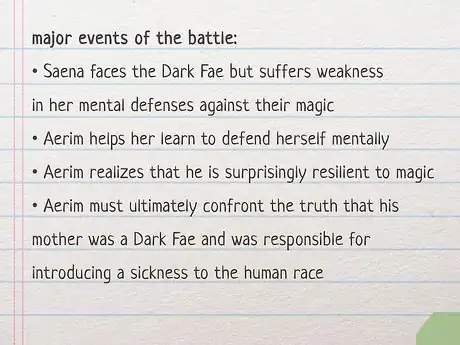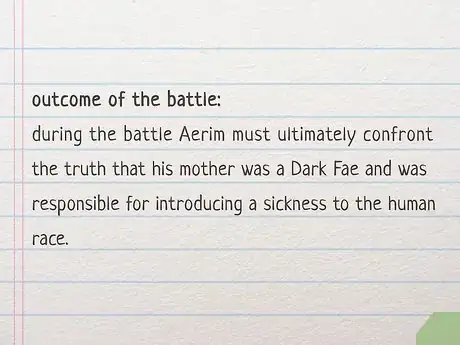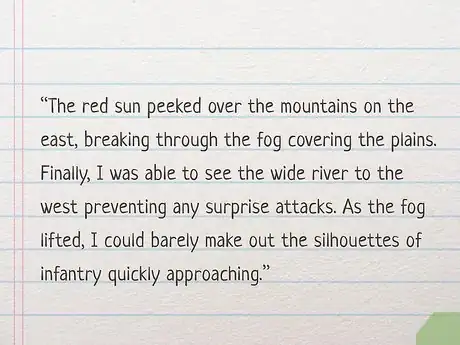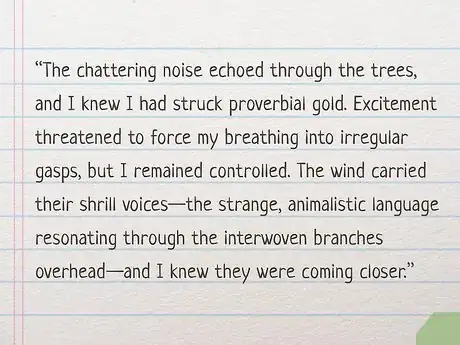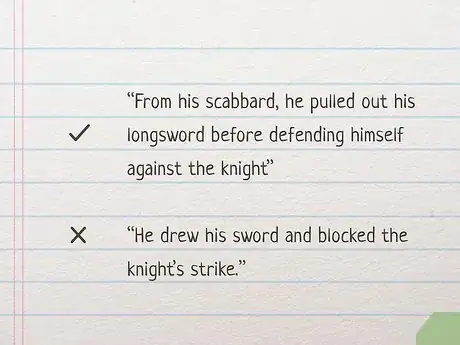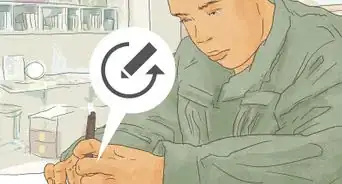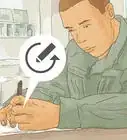This article was co-authored by wikiHow staff writer, Hunter Rising. Hunter Rising is a wikiHow Staff Writer based in Los Angeles. He has more than three years of experience writing for and working with wikiHow. Hunter holds a BFA in Entertainment Design from the University of Wisconsin - Stout and a Minor in English Writing.
There are 11 references cited in this article, which can be found at the bottom of the page.
This article has been viewed 10,449 times.
Learn more...
A memorable battle scene can add a lot of action and tension to your story, but it can feel intimidating to write since there are so many elements to keep track of. No matter what genre you’re writing, your battle should feel exciting and keep your story’s plot moving forward to keep your readers engaged. While it may take time to plan out and work on multiple revisions of the scene, you can easily include epic battles in your writing!
Steps
Outlining the Battle Sequence
-
1Sketch a map to help visualize the battlegrounds. Make a rough drawing of the terrain where you want the battle to happen so you get an idea of the layout. Be sure to include any landmarks, such as mountains, rivers, cities, or castles, since they can influence how the characters fight during the battle. Sketch in the armies or characters that are involved and plan out where they move throughout the space.[1]
- You don’t need to draw a map if you don’t want to, but it can be very helpful for you to understand the layout.
- If you’re basing your story in a real location, look online for a map so you can use it as a reference.
-
2Define your character’s goals and what they expect from the battle. Consider your protagonist’s long-term goal for the story so you can determine why they’re getting involved in the battle. Give them a basic motive, such as power, fear, or survival, to help readers empathize with them more. Then think about the short-term goals that your protagonist wants to achieve during the battle, such as breaking the wall to an enemy fortress or escaping imprisonment.[2]
- Your battle should always affect the protagonist’s progress toward their long-term goals, or else it won’t feel like there were any real conflict or consequences from it.
- Make the battle feel more dramatic by giving the character personal stakes in the battle, such as rescuing a loved one or breaking free from an oppressive ruler.
Advertisement -
3Determine what equipment and forces each side of the battle uses. Consider how large you want to make the armies on each side of the battle in regards to your story. Give each side of the battle special equipment that the other one doesn’t have, such as catapults or advanced technology, to make the battle seem more exciting. Be careful not to make one side too overpowered since it may affect your story’s believability if the weaker forces win.[3]
- Even if you give both sides different weapons or equipment, try to keep them evenly matched to make the scene more dramatic.
Tip: Try making the enemy forces slightly stronger or larger than the protagonist since it can add more tension and drama to your writing. It will also help readers empathize and root for your main character.[4]
-
4Design strategies for each side of the battle. Look at where you drew your protagonist on the map and brainstorm how they would move throughout the battle so they’re able to reach their goal. Then do the same thing for the enemy forces based on what they want to achieve. Try to use different battle plans, such as charging the front lines or performing a sneak attack from behind.[5]
- For example, if your protagonist is a noble fighter, they may try to attack the enemy head-on. However, the enemy forces may try to surprise your protagonist by striking from the flanks.
- Avoid making it too easy for your protagonist to win the battle since it won’t feel as dramatic or satisfying to the reader.
- Opposing forces will rarely have the same battle plans since they are trying to defeat each other and they’ll be viewing the battlefield from different perspectives.
-
5Plan out the major events of the battle. Many battles have a push and pull feeling, where your protagonist may gain ground on the enemy before being pushed back. Create moments where your protagonist feels victorious against the other forces, such as breaking through the front lines or surviving a missile strike. Then add tension to the battle by making the enemy seem more powerful, like bringing out a hidden weapon or destroying a nearby city. Continue writing more events until you reach the final fight in the battle.[6]
- Many battles only last for a few minutes or hours, so keep in mind how long the events last while you’re outlining.
-
6Make a change in the story world with the outcome of the battle. No matter what force you decide wins the battle, consider the consequences that would happen afterward. Think about how the result of the battle changes the overall state of the world and what that implies for your characters’ long-term goals. Determine where you want the story to go after the battle to help you think of how the battle ends.[7]
- For example, if an evil king wins a battle in a city, they may try taking over the land and imposing their own laws.
- As another example, if your protagonist’s long-term goal is to gain power, they may gain the respect from their peers if they win the fight.
Writing Your First Draft
-
1Describe the terrain before the battle starts to set the mood. Include details about the time, landscape, and weather to help your reader visualize the area better. Try to use descriptive adjectives to help paint a better picture of the area. Vary your sentence lengths to keep the reader engaged and make it easier to read. Only write a few paragraphs for your overall description, or else it could slow down the action.[8]
- For example, you could write, “The red sun peeked over the mountains on the east, breaking through the fog covering the plains. Finally, I was able to see the wide river to the west preventing any surprise attacks. As the fog lifted, I could barely make out the silhouettes of infantry quickly approaching.”
-
2Write the experiences of a single character to add more emotion and tension. Rather than writing a general overview for the entire battle, pick a character involved and tell the reader what they’re experiencing. Try to focus on what they see from their perspective throughout the battle so the reader can relate to them more and have someone to root for. Consider what emotions the character feels and what their goals are for the rest of the battle.[9]
- It’s okay to switch between characters during the scene, but consider how each one views the battle differently and what stakes they’re fighting for. For example, infantry in the front lines will have a more difficult experience in the battle than a general who’s watching it from a distance.
-
3Use short and actionable sentences to add a sense of urgency. Avoid using long or complicated words throughout the battle sequence since it could make the writing seem more confusing. Keep your action lines short and to the point to help the battle seem like it’s happening quickly. Try to structure each sentence in the same order that the action occurs, or else someone may need to reread it to understand what’s going on.[10]
- For example, instead of writing, “From his scabbard, he pulled out his longsword before defending himself against the knight,” you could say, “He drew his sword and blocked the knight’s strike.”
- Long sentences can make the action seem slow so the battle won’t seem as dramatic or hectic.
Tip: Look for more actionable versions of verbs for your writing. For example, rather than using “run,” you could instead write, “bolt,” “charge,” or “dart.”
-
4Add sensory details to the scene to make it seem more realistic. Put yourself in your character’s shoes and imagine what they’d experience on the battlefield. Describe what your character sees, smells, hears, feels, and tastes so a reader can picture what’s happening in detail. Use adjectives while describing the action to incorporate the details into your writing easier.[11]
- For example, you may write, “The rain mixed with the blood on the battlefield, filling his nose with the scent of earth and iron. He licked the salty sweat from his lips and continued marching forward. He could barely hear his boots squish through the mud over the shouting and screaming of the infantrymen around him.”
- Avoid overly descriptive paragraphs that don’t contain any action since it will make your writing feel like it’s dragging on.
Revising the Scene
-
1Take a break from your writing after you finish the scene. After you finish working on the first draft of your scene, set it aside for the rest of the night or a few days so you can get some distance from it. That way, when you reread it again, you can see it with fresh eyes so you’re more likely to catch mistakes.[12]
- Try working on a different scene while taking your break. That way, you’re still writing and getting work done.
-
2Read over the scene and highlight any awkward or confusing parts. Reading out loud can also help you catch places where your writing could be smoother. Highlight or underline the sections you have trouble understanding and write a comment about why you were confused. That way, as you go back for revisions, you can remember what you want to change.[13]
- Avoid focusing on spelling or grammar errors during your first revision since they’re minor compared to how well you comprehend the writing.
- Print out your scene if you’re able to since it can be easier to write directly on the paper while you’re editing.
-
3Ask other people to read your scene to get their opinions. Talk to friends or family members that you trust with your writing and see if they’ll look over your work. Tell them any issues you want them to address so they can keep them in mind while they read through the scene. Listen to any feedback they have and ask any follow-up questions for more clarity. If they have trouble reading or understanding what’s happening in the scene, you may need to rework some of your writing.[14]
- You may also reach out to writing teachers or professors you have if you’re in school for additional feedback.
-
4Continue making revisions until you’re happy with the final draft. Work through any feedback that you or another person has given you so the battle reads more clearly. After each revision, take a short break from the writing before reading over it again. Start by focusing on bigger issues, like story structure and comprehension, before working on minor issues, like spelling and grammar.[15]
- It may take multiple revisions to make the scene concise and easy to follow.
Warnings
References
- ↑ https://mythicscribes.com/writing-techniques/how-to-write-battle-scenes/
- ↑ https://www.helpingwritersbecomeauthors.com/writing-epic-battle-scenes/
- ↑ https://www.pcwrede.com/planning-battle-scenes/
- ↑ https://www.freelancewriting.com/creative-writing/how-to-write-great-battle-scenes/
- ↑ https://www.pcwrede.com/planning-battle-scenes/
- ↑ https://mythicscribes.com/writing-techniques/how-to-write-battle-scenes/
- ↑ https://www.helpingwritersbecomeauthors.com/writing-epic-battle-scenes/
- ↑ https://www.freelancewriting.com/creative-writing/how-to-write-great-battle-scenes/
- ↑ https://mythicscribes.com/writing-techniques/how-to-write-battle-scenes/
- ↑ https://www.helpingwritersbecomeauthors.com/writing-epic-battle-scenes/
- ↑ https://mythicscribes.com/writing-techniques/how-to-write-battle-scenes/
- ↑ https://library.defiance.edu/writingprocess/revisingetc
- ↑ http://www.michaelkennethsmith.com/the-writers-dig-with-novel-writing-advice-how-to-write-battle-scenes/
- ↑ https://mythicscribes.com/writing-techniques/how-to-write-battle-scenes/
- ↑ https://mythicscribes.com/writing-techniques/how-to-write-battle-scenes/
- ↑ https://mythicscribes.com/writing-techniques/how-to-write-battle-scenes/
- ↑ https://www.nytimes.com/2019/02/14/books/dan-mallory-woman-window-denzil.html
- ↑ https://writersedit.com/fiction-writing/5-quick-tips-writing-thrilling-fight-scenes/

